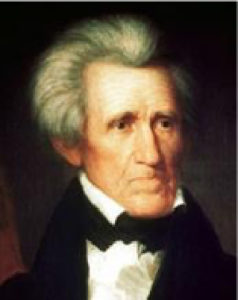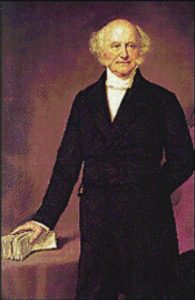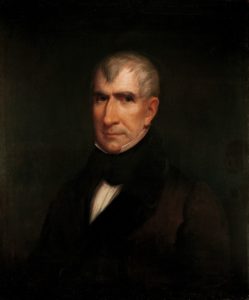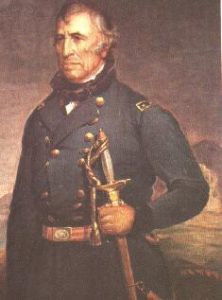The Politics of the Years 1830 to 1861
HISTORICAL OVERVIEW
Throughout the Western world, the end of the Napoleonic Wars brought an end to a period of global war and revolution and the start of a new era of rapid economic growth. For Americans, the end of the War of 1812 unleashed the rapid growth of cities and industry and a torrent of expansion westward. The years following the war also marked a notable advance of democracy in American politics. Property qualifications for voting and office holding were abolished; voters began to directly elect presidential electors, state judges, and governors; and voting participation skyrocketed. In addition, the antebellum era saw a great surge in collective efforts to improve society through reform. Unprecedented campaigns sought to outlaw alcohol, guarantee women’s rights, and abolish slavery.
Rapid territorial expansion also marked the antebellum period. Between 1845 and 1853, the nation expanded its boundaries to include Arizona, California, Colorado, Idaho, Nevada, New Mexico, Oregon, Texas, Utah, Washington, and Wyoming. The United States annexed Texas in 1845; partitioned the Oregon country in 1846 following negotiations with Britain; wrested California and the great Southwest from Mexico in 1848 after the Mexican War; and acquired the Gadsden Purchase in southern Arizona from Mexico in 1853.
The period’s most fateful development was a deepening sectional conflict that brought the country to the brink of civil war. The addition of new land from Mexico raised the question that would dominate American politics during the 1850s: whether slavery would be permitted in the western Territories. The Compromise of 1850 attempted to settle this issue by admitting California as a free state but allowing slavery in the rest of the Mexican cession. But enactment of the Fugitive Slave Law as part of the compromise exacerbated sectional tensions. The question of slavery in the territories was revived by the 1854 decision to open Kansas and Nebraska territories to white settlement and decide the status of slavery according to the principle of popular sovereignty. Sectional conflict was intensified by the Supreme Court’s Dred Scott decision, which declared that Congress could not exclude slavery from the western territories; by John Brown’s raid on Harpers Ferry; and by Abraham Lincoln’s election as president in 1860.
DEBATING THE ISSUES
Between the French Revolution and World War I, the American Civil War was the most violent conflict in the Western world. No topic has aroused deeper disagreement among American historians than the causes of the Civil War. James Ford Rhodes argued that the conflict’s causes lay in the issue of slavery. Charles Beard and Frank Owsley emphasized the economic conflict between an agrarian South and an industrializing North. Charles Ramsdale and James Randall blamed the conflict on irresponsible agitators and blundering politicians operating in an atmosphere of whipped-up emotions and false propaganda.
Today, the debate continues. Michael Holt stresses the importance of the breakdown of the party system, due in part to a massive influx of foreign immigrants into the country. Eric Foner and James McPherson maintain that there were irreconcilable ideological differences between North and South.
Recent explanations of the coming of the Civil War stress three factors. One is contingency–the notion that the conflict was not inevitable, but was the result of a complex set of actions, decisions, and reactions. A second factor is the importance of ideology, the notion that the North and South embraced distinct and mutually antagonistic outlooks and sets of values. The North’s “free labor” ideology portrayed the region as a land of unprecedented equality and opportunity, free of rigid class divisions and glaring extremes of wealth and poverty. The South, in turn, regarded its society as the true preserve of America’s revolutionary traditions, which had been betrayed by an industrializing, urbanizing North.
The third factor is the significance of perception–of how Northerners and Southerners understood the critical events of the antebellum era. Many Northerners came to believe that an aggressive Slave Power had seized control of the federal government, subverted civil liberties, fomented revolution in Texas and war with Mexico in order to expand the South’s slave empire, and wanted to reduce all laborers–white as well as black–to a state of virtual slavery. At the same time, an increasing number of Southerners began to believe that antislavery radicals dominated Northern society and would rejoice in the ultimate consequences of abolition–race war and racial amalgamation.
The antebellum era–the period stretching from the War of 1812 to the Civil War–was an era of political democratization, unprecedented reform energies, and explosive territorial and economic growth. But it also saw the emergence of bitter sectionalism and political conflicts, as the North and South developed along diverging lines. The great question haunting the period was whether the spirit of sectional or the spirit of nationalism would triumph.
The first reform movements in American history arose during the early nineteenth century?
Certain religious developments made Americans more sensitive to sin and increased their faith in peoples’ ability to cure social problems. The liberal revolt against Calvinism convinced many reformers that people were basically good and that only a flawed environment caused social evils. The evangelical revival defined sin and concrete terms and encouraged reformers to address social problems. At the same time, in an increasingly urban society, some problems had become more visible. But reformers also had a heightened faith in peoples’ ability to cure social problems.
The antislavery movement, which was nearly as unpopular in the North as the South in the early 1830s, able to persuade a growing number of Northerners that slavery was an intolerable moral evil?
Certain changes made the American political system more democratic between 1820 and 1840. These changes were: The elimination of property qualifications for voting; direct election of judges, governors, and presidential electors; the emergence of political nominating conventions; the elimination of voting by voice; and popular campaigning.
At the same time the doctrine of “manifest destiny” made westward expansion seem like a noble thing to do. Americans began to move westward between 1820 and 1850, and were largely they motivated mainly by national pride and a desire to spread American institutions or by lust for land and resources. However, the motives varied widely. Some were motivated by land hunger. Others sought to preempt settlement by other nations. The Mormons were motivated by a desire for religious freedom.
On the eve of the Civil War, a growing number of Northerners had come to believe that an aggressive southern Slave Power had seized control of the federal government and threatened to subvert republican ideals of liberty, equality, and self-government. Many Northerners come to hold this view encouraged by the debate over the Gag Rule, the Amistad case, Texas annexation, the Mexican War, the Fugitive Slave Law, the defeat of the Wilmot Proviso, the passage of the Fugitive Slave Law and the Kansas-Nebraska Act. The Dred Scott decision convinced many Northerners that slavery threatened their civil liberties and that the Slave Power had seized control of the federal government.
John Brown’s raid and Lincoln’s 1860 election as president convinced slaveholders that they needed to secede from the Union. Many were convinced that the South was losing the ability to shape national decisions; that the North was unified in opposition to slavery; and that an antislavery president could take steps to weaken the institution of slavery.
Ref.: Portions of the above section are based on Chap. 7 of The Boisterous Sea of Liberty – A Documentary History of America from Discovery through the Civil War
David Brion Davis, Steven Mintz, Oxford University Press
The Presidential Elections 1832 – 1856
1832 – 1832 was the first election in which the candidates were nominated by national nominating conventions. Democrats met in Baltimore and overwhelmingly nominated Andrew Jackson. Henry Clay was nominated by the National Republicans at their convention in Baltimore. The major issue in the campaign was Jackson’s determination to eliminate the Bank of the US. Jackson had vetoed the bill reauthorizing the bank shortly before being renominated. Henry Clay decided to make the veto the major issue in the campaign, but it worked very much to in Jackson’s advantage as the bank was considered a tool of the rich. Jackson won by an overwhelming margin.
Ref.: History Central.com
1836 – Martin Van Buren was the personal choice of Andrew Jackson and faced no opposition for the Democratic nomination. The Whigs, however, were badly split and decided to field a number of regional candidates in the hope of having the issue decided by the House of Representatives (as had been the case in the Election of 1824). William Henry Harrison, hero of the Battle of Tippecanoe, hoped to gain the support of Western voters, Daniel Webster had strength in New England, and Hugh Lawson White had backing in the South.
In the end Van Buren destroyed the Whig strategy by polling well in all sections of the country. The Whigs, however, were able to make significant gains in Congress.
As a historical footnote, no vice-presidential candidate received a majority of the electoral votes cast in 1836. Under the provisions of the Constitution (see Twelfth Amendment), the Senate was to make the final determination. Richard M. Johnson (Kentucky) was chosen to serve with Van Buren. This was the only instance in which the Senate has been called upon to perform this duty.
Ref.: http://www.u-s-history.com/pages/h350.html
1840 – Martin Van Buren was re-nominated unenthusiastically by the Democrats in 1840; no candidate was nominated for the vice presidency. To many of those countrymen who had suffered through years of depression, he was “Martin Van Ruin.”
Henry Clay felt his time had finally arrived and anticipated receiving the Whig nomination. Other forces in the party, however, knew that Clay’s prominence over the years had earned him many enemies and they backed William Henry Harrison once again. Harrison was an old war hero and had made few pronouncements on public issues—a situation similar to Andrew Jackson in 1824. For regional balance, John Tyler of Virginia was selected as the vice-presidential candidate; Tyler was a former Democrat and would later return to many of his earlier beliefs. The campaign slogan was, “Tippecanoe and Tyler, too!”
The campaign of 1840 was heavy on image-making, less so on substance—a harbinger of things to come. One Democratic wag observed that Harrison would probably be just as happy with a jug of hard cider to sip in front of his log cabin as serving as president. The Whigs turned this contemptuous statement to their advantage and launched the “log cabin and hard cider” campaign, playing up Harrison’s appeal to the masses and serving large quantities of hard cider at rallies. On the other side Van Buren was attacked for alleged elitism; he was a well-dressed dandy and consumer of fine wines and exotic foods. Aspiring political poets of the day offered such verse as:
Let Van from his coolers of silver drink wine
And lounge on his cushioned settee,
Our man on a buckeye bench can recline,
Content with hard cider is he.
Neither portrayal was accurate. Harrison had many aristocratic qualities and came from a wealthy family, while Van Buren was a self-made man who was a firm believer in democratic values.
The election results appeared to be a landslide in the Electoral College, but the popular vote was close.
Ref.: http://www.u-s-history.com/pages/h300.html
1844 – Democratic Nomination
Democrats nominated dark horse candidate James Knox Polk on the ninth ballot of the Democratic National Convention after party favorite Martin Van Buren lost the bid because of his opposition to annexing Texas, a position deemed unacceptable by Southerners and by former president Andrew Jackson.
Told of his nomination in a letter, Polk penned the reply: “It has been well observed that the office of President of the United States should neither be sought nor declined. I have never sought it, nor should I feel at liberty to decline it, if conferred upon me by the voluntary suffrages of my fellow citizens.”
General Election
Though a veteran politician, Polk entered the 1844 presidential campaign with little name recognition. Playing on his relative obscurity, the Whig opposition sniped “Who is James K. Polk?” An experienced and eloquent orator dubbed the “Napoleon of the Stump,” Polk campaigned vigorously, surprising many with his stalwart support of westward expansion–a hotly-debated issue dodged by other candidates.
In the end, Polk’s policies paid off. On November 5, 1844, Polk defeated Whig party candidate Henry Clay to become the eleventh president of the United States. He won 170 electoral votes to Clay’s 105, with a margin of victory was just 38,000 popular votes.
Ref.: http://www.knowledgerush.com/kr/encyclopedia/U.S._presidential_election,_1844/
1848 – The U.S. presidential election of 1848 was an open race. President James Polk, having achieved virtually all of his objectives in one term and suffering from declining health that would take his life less than four months after leaving office, kept his promise not to seek re-election.
The Whigs in 1846-47 had focused all their energies on condemning Polk’s war policies. They had to quickly reverse course. In February 1848 Polk surprised everyone with the Treaty of Guadalupe Hidalgo that ended the war and gave the U.S. vast new territories (including California and most of Arizona and New Mexico). The Whigs in the Senate voted 2-1 to approve the treaty. Then in the summer the Whigs nominated the hero of the war, Zachary Taylor. While he did promise no more future wars, he did not condemn the war or criticize Polk, and Whigs had to follow his lead. They shifted their attention to the new issue of whether slavery could be banned from the new territories. The choice of Taylor was almost in desperation and an immense acquisition of Land will be pointed to as the result of Democracy — the Land stealing, even among our best Christians, is popular!” [Holt p. 312]
Nominations
Whig Party nomination
Mexican War General Zachary Taylor of Louisiana, spurred by his successes on the battlefield but who had never voted in an election himself, was openly courted by both the Democratic and Whig parties. Taylor ultimately declared himself a Whig, and easily took their nomination, receiving 171 delegate votes to defeat Henry Clay, Winfield Scott, Daniel Webster and others. Millard Fillmore received the party’s nomination as Vice President.
Democratic Party nomination
Free Soil Party nomination The Democrats countered by nominating Lewis Cass, who had served as Governor and Senator for Michigan, as well as Secretary of War under Andrew Jackson, and from 1836–1842 as ambassador to France. General William Orlando Butler was nominated to join Cass on the ticket, garnering 169 delegate votes to defeat five other candidates, including future Vice President William Rufus deVane King and future Confederate President Jefferson Finis Davis. The Democrats chose a platform that remained silent on slavery, and with Cass suspected of pro-slavery leanings, many anti-slavery Democrats walked out of the Baltimore convention to begin the Free Soil party.
A third party, the Free Soil Party, was organized for the 1848 election to oppose further expansion of slavery into the western territories, and hopefully to obtain the abolition of slavery itself. Led by Salmon P. Chase and John P. Hale, former President Martin Van Buren defeated John Parker Hale by a 154-129 delegate count to capture their nomination, while Charles Francis Adams was chosen as the Vice Presidential nominee.
General election
Campaign
With Taylor remaining vague on the issues, the campaign was dominated by personalities and personal attacks, with the Democrats calling Taylor vulgar, uneducated, cruel and greedy, and the Whigs attacking Cass for graft and dishonesty. The division of the Democrats over slavery allowed Taylor to dominate the Northeast.
Results
With the exception of South Carolina, which left the selection of electors to its legislature, the election of 1848 marked the first time in which every state in the union voted for President and Vice President on the same day: November 7, 1848. Taylor won election over Cass, capturing 163 of the 290 electoral votes cast.
Ref.: http://en.allexperts.com/e/u/un/united_states_presidential_election,_1848.htm
1852 – For Whig candidate Winfield Scott, the Election of 1852 began with the death of Zachary Taylor in 1850. Scott personally arranged the military escort, with himself in the lead. He moved his office from New York to Washington and began lobbying Congressmen to vote for Henry Clay‘s Compromise of 1850. Scott’s friend, Millard Fillmore, then President of the United States, and Secretary of State Daniel Webster were all competing for the nomination. It was obvious from the start that Fillmore’s reputation had been deeply damage by his support for the Compromise, and Daniel Webster was equally damaged by his Seventh of March speech.
With the three most powerful men in America (President, Secretary of State and General-in-Chief) struggling for the Whig nomination, Democrats secretly turned to a committee to win the presidency back. James Polk’s friend, Gideon Pillow, joined a committee including Jefferson Davis John A. Quitman, Thomas L. Clingman and Caleb Cushman. Pillow, one of the worst general on either side of both the Mexican-American and Civil Wars, actually tried to take the nomination himself, but when the committee was done it recommended Franklin Pierce. At the Democrat Convention in Mechanics Institute in Baltimore, Maryland, Lewis Cass, Stephen A. Douglas, James Buchanan, and William L. Marcy all competed for the nomination, but none could come up with the 2/3rds majority to win. Finally, the name of Franklin Pierce was entered into the fray and on the 48th ballot he won.
At the Whig Convention, also in Mechanics Institute in Baltimore, Maryland, New Yorker Millard Fillmore enjoyed the support of the South because he signed the Fugitive Slave Law, while northern Whigs would not elect him for the same reason. Webster had backing from New England in spite of his speech while Scott was the favorite of party stalwarts William Seward and Thurlow Weed. In retrospect, the divisions that appeared at the Whig convention should have been seen as the “writing on the wall” for the Whigs, but this was politics as usual in the years before the Civil War. Scott lacked support in the South. Tennessee congressman Meredith Gantry said if he won, he would be the weakest man ever run for the Presidency. When balloting began, Fillmore was the clear leader, but when he did not win on the first round votes trickled away, not to Webster, but to Scott. A week and 53 ballots later, Scott was the party’s nominee.
The Whig Party had serious internal issues stemming from the Northern Whig adherence to abolition, a concept the Southern Whigs rejected. In August, three Whigs (Charles Sumner, Joshua Giddings and Charles Francis Adams) broke with the party and held a third-party Freesoil convention. That convention nominated John Parker Hale, a U. S. Senator from New Hampshire and an avid abolitionist.
Issues
The underlying debate over slavery seemed muted, perhaps because of the Compromise of 1850 and because the free states now had firm control of both the House and Senate. Other reasons for the lack of actual political disagreement were the similarity of the Democrat and Whig party platforms and fear over alienating one wing of the party or the other.
As a result, the Election of 1852 became massive personal attacks on the candidates. Pierce was called “the fainting general” because he passed out from the pain of being shot in the ankle and remained on duty. Attacks were also made on Pierce for his excessive drinking, which he had carefully hidden. Winfield Scott was a prime target for attack, from his wound “in the rear” at Lundy’s Lane to his nickname, Old Fuss and Feathers.
In the end, the three party election proved to be telling of the future division of the United States. When the election returns were tallied, the Freesoil nominee, John Parker Hale, succeeded in drawing almost 5% of the vote. This was a significant drop from Martin Van Buren’s 10% of the vote as the Freesoil candidate in 1848, but it showed the abolitionist movement was still alive and well. As a result of Hale’s numbers, Pierce barely won a majority of popular votes but he won all states except Tennessee, Kentucky, Vermont and Massachusetts.
This was the last election in which the Whigs were a viable force. By the time the Election of 1856 came around the Freesoilers had merged with the northern Whigs and formed the Republican Party. Some blame Scott’s candidacy with the destruction of the Whig Party, but it actually had little to do with the party’s downfall. A number of issues, including the inability of the party to be able to resolve the same sectional crisis that created the Civil War, were the major contributing factors.
Ref.: http://hd.housedivided.dickinson.edu/?q=node/9586
1856 – Stephen A. Douglas coveted the Democratic nomination in 1856, but his reputation had been badly tarnished by the ongoing violence in Kansas. In his place the Democrats turned to James Buchanan, who had been the minister to Britain from 1853 to 1856 and was not linked to the Kansas issue. Further, Buchanan was popular in the South because of his part in the Ostend Manifesto.
The Republicans ran their first presidential campaign in 1856, choosing noted Western explorer John C. Frémont, “The Pathfinder.” Frémont had no political record (regarded as a plus), but held abolitionist views (a negative in the eyes of many moderates).
The American Party (Know-Nothings) nominated former president Millard Fillmore and capitalized on nativist discontent.
The Republicans ran a campaign calling for repeal of the hated Kansas-Nebraska Act, opposition to the extension of slavery into the territories and support for internal improvement projects. They also took every opportunity to blame the Democrats for the horrors of “Bleeding Kansas.”
Buchanan emerged the victor, but failed to gain a majority of the popular vote. In fact, a shift of a small number of votes in several states would have tipped the electoral tally to the Republicans. Mirroring the sectional feelings of the day, the Democrats were strong in the South, the Republicans in the North. The election in 1856 brought a weak president to leadership in a badly divided nation.
Ref.: All pictures from the Picsearch collection – www.picsearch.com




